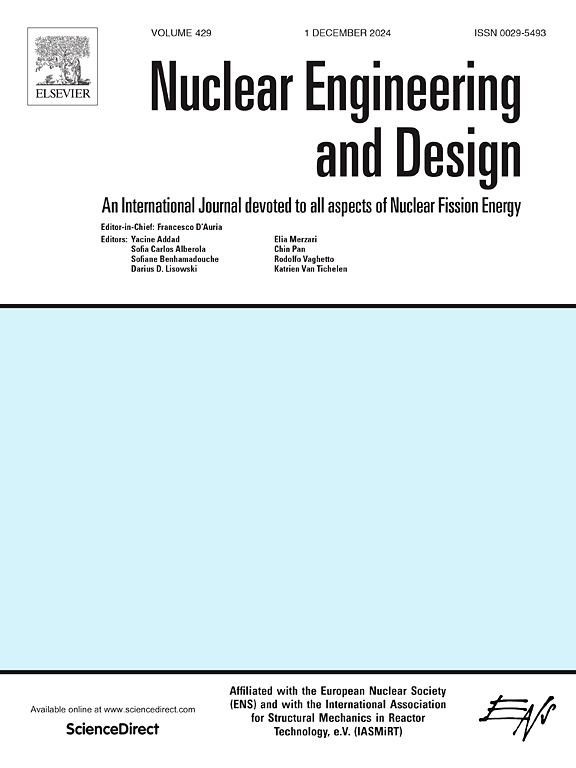Modelling of bubble formation phenomenon at top-submerged nozzles with side hole submerged in a quiescent liquid
IF 1.9
3区 工程技术
Q1 NUCLEAR SCIENCE & TECHNOLOGY
引用次数: 0
Abstract
Efficiency of a gas-injection based passive liquid mixing device depends on size of gas bubbles produced as it affects bubble rise velocity and hence gas hold-up volume. Typically, such devices employ gas dispersion through a foot-piece having side holes immersed in a liquid. Despite of their relevance, such devices and phenomena relevant to such devices have not been explored sufficiently. A key relevant phenomenon is bubble formation at a side hole in a nozzle immersed in a quiescent liquid. Therefore, an experimental study is conducted to investigate this phenomenon. Liquids used in the study are relevant to radiochemical plants which need such passive mixing devices. An empirical correlation is obtained to estimate bubble size using the experimental data. Absolute average relative deviation between predicted and measured bubble diameter values is ∼ 9 %. To develop a generalised framework to predict bubble diameter, force balance based mathematical modelling is also attempted. Validation of the mathematical model with experimental data is carried out. Average absolute relative deviation for this validation is ∼ 16 %. A parametric analysis using the mathematical model is also conducted to examine how various independent variables influence bubble size. The impact of these independent variables on bubble size is assessed through sensitivity analysis.
边孔浸没在静液中的顶部浸没喷嘴气泡形成现象的模拟
注气型被动液体混合装置的效率取决于产生的气泡的大小,因为它影响气泡的上升速度,从而影响气含量。典型地,这种装置利用气体分散通过一个脚片,脚片的侧孔浸没在液体中。尽管它们具有相关性,但这些装置以及与这些装置相关的现象尚未得到充分的探索。一个关键的相关现象是浸泡在静止液体中的喷嘴侧孔处形成气泡。因此,本文对这一现象进行了实验研究。研究中使用的液体与需要这种被动混合装置的放射化工厂有关。利用实验数据对气泡大小进行了经验关联估计。预测和测量的气泡直径值之间的绝对平均相对偏差为~ 9%。为了建立一个广义的框架来预测气泡直径,还尝试了基于力平衡的数学建模。用实验数据对数学模型进行了验证。该验证的平均绝对相对偏差为~ 16%。利用数学模型进行了参数分析,以检验各种自变量如何影响气泡大小。通过敏感性分析评估这些自变量对气泡大小的影响。
本文章由计算机程序翻译,如有差异,请以英文原文为准。
求助全文
约1分钟内获得全文
求助全文
来源期刊

Nuclear Engineering and Design
工程技术-核科学技术
CiteScore
3.40
自引率
11.80%
发文量
377
审稿时长
5 months
期刊介绍:
Nuclear Engineering and Design covers the wide range of disciplines involved in the engineering, design, safety and construction of nuclear fission reactors. The Editors welcome papers both on applied and innovative aspects and developments in nuclear science and technology.
Fundamentals of Reactor Design include:
• Thermal-Hydraulics and Core Physics
• Safety Analysis, Risk Assessment (PSA)
• Structural and Mechanical Engineering
• Materials Science
• Fuel Behavior and Design
• Structural Plant Design
• Engineering of Reactor Components
• Experiments
Aspects beyond fundamentals of Reactor Design covered:
• Accident Mitigation Measures
• Reactor Control Systems
• Licensing Issues
• Safeguard Engineering
• Economy of Plants
• Reprocessing / Waste Disposal
• Applications of Nuclear Energy
• Maintenance
• Decommissioning
Papers on new reactor ideas and developments (Generation IV reactors) such as inherently safe modular HTRs, High Performance LWRs/HWRs and LMFBs/GFR will be considered; Actinide Burners, Accelerator Driven Systems, Energy Amplifiers and other special designs of power and research reactors and their applications are also encouraged.
 求助内容:
求助内容: 应助结果提醒方式:
应助结果提醒方式:


